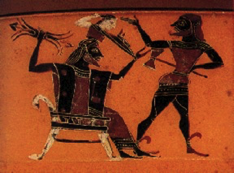Toward an Ungendered Childbearing:
Deconstructing Assumptions of Femaleness in Pregnancy and Birth
November 14, 2017
[This essay was originally written in 2006, with last major edits in 2008, and minor edits for language since. Please let me know your thoughts if you notice anything else that needs to be brought into the current decade!]
Our society strongly links childbearing with womanhood. There is historical ground for this assumption—most of the people who give birth in our society are cisgender1 women. However, it is never prudent to generalize “most” to “all.” Some trans men and nonbinary people choose to bear children, and this assumption of birth as a “woman thing” is damaging to non-female-identified people who choose to become pregnant, as well as to their communities. Throughout time and across cultures, we see myths and images of non-female pregnancy and birth. This history, combined with a feminist deconstruction of gender, can serve as a foundation for opening the experience of childbearing to trans men without the current implication of femaleness.
Human obsession with male pregnancy and birth is not new; who knows how long people have related stories of cisgender men who bear children? Our earliest recorded example, in Greek mythology, is that of Zeus birthing two of his own children. The king of the gods swallowed his pregnant first wife, Metis; their child Athena later sprang from his head fully armed (1, ll. 924-929t). Similarly, Dionysus was gestated in and birthed from an incision in Zeus’s thigh (2, ll. 119-130).
The theme of male pregnancy in mythology shows up across cultures: Osset mythology tells of Batraz—his mother was a frog-woman, who became pregnant and spit the fetus into her husband’s shoulder. The baby Batraz grew into an abscess and was born when it burst. A Hindu tale relates how a lotus flower emerged from the navel of Vishnu and bloomed to reveal the infant Brahma. The Norse trickster-god Loki is said to have become pregnant while embodying a mare to distract an opponent’s horse; he later gave birth to the 8-legged horse Sleipnir, favored steed of Odin. Of all these, however, my favorite of the male birth stories I have found is a very sweet Inuit creation myth.
In the time that followed there appeared two small mounds of earth from which were born two men, two adults, the first Inuit. They soon wished to reproduce, and one of them took the other to be his wife. The wife-man became pregnant and when his time came, his companion, anxious to bring the fetus out, composed a magic song:
Here is a man
Here is a penis
May he form a passage there
A great passage
Passage, passage, passage.
The song split the penis of his partner, who was transformed into a woman. All of the Inuit descend from them.
(3, p. 252)
These tales have a few common themes in addition to non-female birth. Usually, the father is a god and the child born is special somehow—either also a god or someone else destined for greatness.
Since the days of Hesiod and Euripides, extra-uterine pregnancy has remained on people’s minds, and the theme extends through the Middle Ages, when there were many rumors of pregnant men2, and into contemporary culture. Many writers have employed the plotline, often creating utopian or anti-utopian worlds, such as in Durrell Owens’ 2004 novel, The Song of a Manchild. Tabloids rely heavily on exceptional reproduction, including male pregnancy. Films have addressed the topic as well, starting with the 1976 French film A Slightly Pregnant Man and 1978 Rabbit Test to Schwarzenegger’s 1994 Junior.
Fictitious characters are not the only uterus-free people getting pregnant. Some men have themselves replicated pregnancies and labor within their own bodies. At least, they imitate the symptoms, like morning sickness, cravings, weight gain and contractions. This is called “couvade” or “sympathetic pregnancy.” The symptoms coincide with those of the pregnant person, usually a partner, though siblings and close friends have also reported symptoms.
For those who don’t happen to have couvade symptoms, there’s always the Empathy Belly (4), a device designed to show the wearer what it feels like to be pregnant. Empathy Bellies have been used as part of sex-ed training for teens, but are primarily used by those with pregnant partners. The use of an Empathy Belly is said to “greatly increase [the wearer’s] sense of involvement, gut-level awareness and empathy…appreciation, communication and supportive behavior towards their pregnant partner” (4).
Couvade and the Empathy Belly are commonly perceived as non‑threatening and even a bit comical. In theory, men who share or even just understand how difficult pregnancy can be are more compassionate toward their pregnant partners. Couvade and Empathy Bellies can be seen as relatively inoffensive, even jokey, because no man is literally pregnant.
In the near future, however, uterus-less people may achieve literal pregnancy (and the corresponding scores of offended people). A small handful of scientists around the world are working to achieve this feat, although none have succeeded yet. The theory is built upon past cases of ectopic pregnancies3 being carried to term and born healthy. In people without a uterus, doctors would implant an embryo into the abdominal cavity by in vitro fertilization, in hopes it will attach to the peritoneum. After nine months, the baby would be born via Caesarean. The primary concern would be the very high and deadly risk of hemorrhage when detaching the placenta from the abdomen. Other researchers are working on the possibility of uterus transplants, though it seems they would be temporary, removed when the patient is done with childbearing, to avoid life-long use of anti-rejection medications.
There is much debate around the ethics of male pregnancy. Much of the argument against it pertains to the hormone therapy. Because a fetus is technically a parasite or foreign object, the immune system will destroy it unless adequate levels of progesterone are present4. For someone without ovaries, this would involve taking a large amount of progesterone and estrogen. Some people see this as unnatural, violating the biological order of things because it blurs the line between genders.
This objection is problematic for several reasons: firstly, it does not take into consideration the many trans women who are already taking “female” hormones (or would like to), and desire to bear their own children. One doctor, Chen Huanran, of Chinese Academy of Medical Sciences in Beijing, does take this into account. As a prominent surgeon doing gender confirmation surgeries, Chen’s research in intra‑abdominal pregnancy is motivated by transfeminine patients who “expressed a wish to have their own children” (5).
The second problem with this objection is the assumption of a biological “line between genders” in the first place. This is closely related to the societal construct of the gender binary: when people are forced into one box or another, the line that separates them becomes very important. Societal panic surrounds this issue because the “line between genders” enforces the belief that women are “supposed” to be mothers. The Freudian concept that “biology is destiny” described an essentialist womanhood that innately depends on bearing children: “motherhood as natural fulfillment of female biological destiny” (6). One inevitable side‑effect of this theory is the corollary that pregnancy equals womanhood. When womanhood becomes motherhood, it is practically impossible for pregnancy to be seen as anything other than necessarily female.
From Zeus and Schwarzenegger to couvade and cutting-edge reproductive science, some scholars argue that these portrayals of pregnant men evidence an innate masculine desire to bear children. Karen Horney refers to this concept as “womb envy,”5 as her theories both correspond to and challenge Freudian “penis envy.” “Womb envy” is embraced primarily by essentialist feminism, which posits that women and men are inherently, biologically different. Essentialist feminism argued that women are “more maternal and nurturing, hence better parents and more likely to be peacemakers; more moral, hence better social gatekeepers and more ethical politicians or leaders; better communicators; less violent; less competitive; and just generally Venusian” (7, p. 64). Under this essentialist framework, “womb envy” seeks to explain male aggression and misogyny, but totally neglects anyone who does not conform to gender binaries, gender roles, or gender norms.
Most current theorists, however, reject Horney’s hypothesis and essentialism generally, leaning toward social constructionism, a theory that says most social phenomena, including gendered traits, are a product of our culture. Each framework has a markedly different interpretation of identity: “Whereas essentialists regard identity as natural, fixed and innate, constructionists assume identity is fluid, the effect of social conditioning and available cultural models for understanding oneself” (8, p. 8). As gender is socially constructed, so too is the assumption that pregnancy inherently falls within femaleness. Like most socially constructed beliefs, however, people remain highly attached to them, often unable even to imagine the possibility of other truths.
At the original time of writing, there was a media uproar surrounding Thomas Beatie, an Oregon man who announced his first viable pregnancy in 20086. He had been dismissed as a hoax and as a freak, but the truth is, he’s a garden variety trans guy. This means he was born with the parts society tends to associate with women, and can thus carry a healthy baby in his uterus. While tabloid headlines can be obnoxious and hurtful, the backlash that I find most concerning is that I hear from others in the trans community.
Various online forums for trans folks contain lengthy, heated threads7 about Beatie and transmasculine pregnancy in general8. Some posters are supportive, but others express strong disapproval. Similar to reactions among some members of general society, I read of trans people questioning the masculinity and transgender status of trans men who choose to bear children. Apparently, pregnancy is seen as such a strong marker of femaleness that even in the trans community, it overrides the rest of Beatie’s life and male identity. After struggling to be recognized as men, trans men often feel they are forced to choose between parenting and their perceived manhood. This is disconcerting, and further evidences the need to break down the assumed connection between pregnancy and womanhood. In the nearly ten years since I originally wrote this piece, Beatie’s fame has waned. Many other trans folks have welcomed babies into their families—some hiding the entire pregnancy from everyone; others smothered by media and harassed by total strangers. While Beatie was the first to include the media in his story, he was not the first, and has certainly not been the last. For the most part, however, the social push-back has remained. As a care provider, as a trans person, and as a compassionate human being, I’m very alarmed at the refusal to acknowledge those pregnant folks who are not women. This refusal comes at the expense of trust and the client-practitioner relationship, in turn compromising prenatal care and their clients’ mental and overall well-being.
Trans men have inherited the legacy of Zeus and his “male womb” (2, ll. 658). However, they do not have to birth children from their navels or heads, but can carry children safely and naturally in their uteruses. Pregnant men may not be seahorses or gods, but they are still men, and need not give up their masculinity in order to grow their families as they see fit. We need to create a new social space for male pregnancy and birth. When childbearing can be no longer coded “female,” any parent will be free to bear and raise a child, seen and supported.
[Thank you for reading! I intend to add more about seahorses, the Sims, nonbinary folks, medical advances, and more recent and specific trans-antagonism, as well as a new conclusion and possible intro paragraph. Lemme know if you find any problematic outdated language, or just where you’d love to see this piece go.]
References
1. Hesiod. The Theogony. Trans. H G Evelyn-White. Out-of-print; available at: https://www.sacred-texts.com/cla/hesiod/theogony.htm Accessed Dec 2018.
2. Euripides (2003). The Bacchae. Trans. I Johnston. Nanaimo, BC: Prideaux Street Publications.
3. Rasmussen, K. (1929). Intellectual culture of the Iglulik Eskimos, Report of the fifth Thule expedition, Vol. 7. Copenhagen.
4. Birthways Childbirth Resource Center (2000). Expectant fathers and the empathy belly pregnancy simulator. Available at: https://www.empathybelly.org/ Accessed Dec 2018.
5. China.org.cn. Male pregnancy now an option, Beijing surgeon says. Available at: www.china.org.cn/english/2002/May/33452.htm Accessed Nov 2017.
6. Gurel, P. (2005). In passing room 10: Motherhood and the beats. Quiet mountain: New feminist essays—A monthly journal of women’s writing, 2 (IX). Available at: www.quietmountainessays.org/Gurel.html Accessed Nov 2017.
7. Fudge, R. (2006). Everything you always wanted to know about feminism but were afraid to ask. Bitch, 31, 58-67.
8. Jagose, A. (1996). Queer Theory: An Introduction. New York: University Press.
Footnotes
- Cis means “on this side of” or “same.” “Cisgender” here is set as an antonym to “transgender” and refers to those whose gender identity is in accordance with their assigned gender. The term was developed based on the theory that providing labels for all groups prevents one “default” group from being normalized while the named group becomes othered and stigmatized.
- I could not find any quotations on the topic, but I believe the rumors or hoaxes circulated in the midst of those of women birthing rabbits and monsters.
- Ectopic pregnancies are those that occur outside the uterus. Most often these are tubal pregnancies, in the fallopian tubes. Tubal pregnancies are not viable and can be very dangerous. Viable ectopic pregnancies occur in the abdominal cavity. There have been cases of babies carried to term this way after hysterectomy, although never intentionally.
- The reasons are unclear, but I presume that the mechanism is similar to rejection of transplanted organs.
- Horney’s “womb envy” theory is referenced by many feminist scholars. Though I was unable to find her actual writings, it appears that she may have developed this theory in her 1932 paper, “The Dread of Woman.”
- Beatie’s first pregnancy was ectopic and ended in fetal loss.
- For purposes of confidentiality, I am not citing these posts and conversations.
- Though Beatie is the first to garner media attention, other trans men have birthed their own children, most notably Matt Rice, then-partner of author Patrick Califia. Numbers are hard to come by, as recording laws vary and many trans people are not out.

Author Bio: J Moon, BS Midwifery, LMT-retired (they/ them)
Perinatal care specialist. Parent of two. Hosted three--now FOUR--fetuses: my big kid, a surrogacy in the middle, and my little kid...added another adorable surrogacy baby. Vegan; drinks a lot of tea. Board game (and general) geek. Goat hugger extraordinaire.
Read more about J here.



